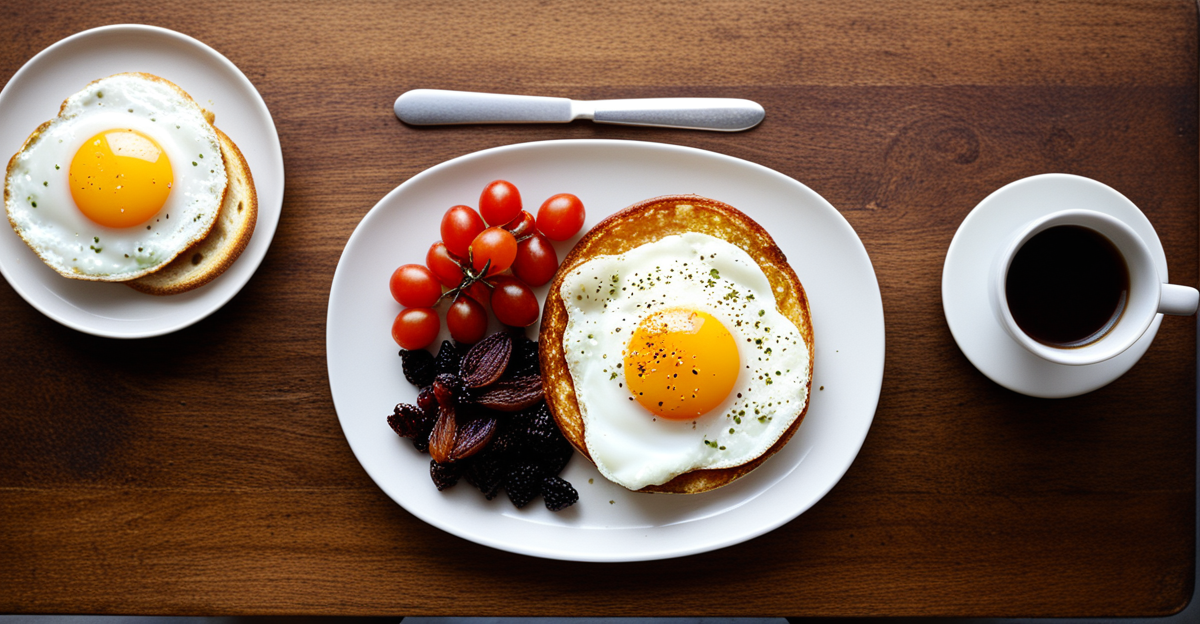Essential Ingredients for a Traditional English Breakfast
The full English breakfast is a balanced ensemble of flavors and textures, each ingredient playing a vital role. Core components include eggs, bacon, sausages, baked beans, grilled tomatoes, mushrooms, and toast. The combination of these ingredients creates the iconic hearty meal loved across Britain.
Eggs are typically fried or poached, presenting a runny yolk that complements the crispy bacon and juicy sausages. For authentic English breakfast ingredients, opting for pork sausages and back bacon enhances the richness. When choosing brands, British staples like Cumberland sausages or Wiltshire cure bacon offer genuine flavor. Beans are commonly in a lightly spiced tomato sauce and add a sweet contrast.
This might interest you : How do you create a classic bangers and mash dish?
Regional variations might include black pudding or hash browns, but sticking to the essentials ensures authenticity. Mushrooms are usually pan-fried until golden, while tomatoes should be grilled or roasted. Toast, preferably buttered white or wholemeal bread, rounds out the plate with a satisfying crunch. Understanding what’s in an English breakfast helps preserve this classic dish’s integrity while allowing room for personal touches.
Step-by-Step Guide to Cooking Each Breakfast Item
Mastering how to make English breakfast involves timing and technique to ensure each component is cooked flawlessly. Begin with sausages, as they require the longest cooking time—about 15 minutes over medium heat, turning frequently. This ensures even browning and thorough cooking without burning. Meanwhile, grill or pan-fry the bacon on medium-high heat for 5–7 minutes until crisp but not overdone.
Also read : How do you create a classic bangers and mash dish?
When it comes to eggs, fried or poached remain traditional. For frying, use a non-stick pan with a touch of butter or oil over medium heat; cook whites until set but yolks remain runny, usually 3–4 minutes. Poached eggs need simmering water and vinegar, cooked gently for 3–5 minutes to get that perfect soft center.
Grilled tomatoes and sautéed mushrooms are cooked quickly: tomatoes pressed cut-side down for 2–3 minutes, mushrooms in butter for 5 minutes until golden. Baked beans simply need warming on low heat to preserve their texture. Toast should be prepared last, either in a toaster or under a grill, to keep it warm with a crunchy edge.
Simultaneously cooking these items requires coordination: sausages and bacon start together, followed by mushrooms and tomatoes; eggs and toast finish last. Using multiple pans or an oven can help keep everything hot and ready at the same time.
Nutritional Information and Considerations
Understanding English breakfast nutrition is key for those who want to enjoy this classic meal mindfully. A traditional full English breakfast is calorie-dense, typically ranging from 700 to 1,200 calories depending on portion sizes and ingredient choices. The meal is high in protein from eggs, bacon, and sausages, which supports muscle maintenance and satiety. However, it can also be rich in saturated fats and sodium, raising concerns for heart health if consumed frequently.
For those wondering, how many calories in English breakfast often comes from the fatty meats and buttered toast. One pork sausage can add 150–200 calories; back bacon contributes around 100 calories per slice. Eggs add 70 calories each, with beans, tomatoes, and mushrooms providing much-needed fiber, vitamins, and antioxidants to balance the meal.
To make a healthier full English without losing the essence, consider leaner sausage varieties, grilling instead of frying bacon, or swapping white toast for wholemeal. Portion control also matters: smaller servings still satisfy but cut excess calories. Adding more grilled tomatoes and mushrooms enriches nutrition while keeping the meal flavorful. These tweaks preserve what’s in an English breakfast while supporting better dietary balance.
Common Variations and Substitutions
Exploring English breakfast variations adds welcome diversity while respecting classic flavors. Regional twists, such as the Scottish full breakfast, often include black pudding or haggis, providing a richer, spiced flavor. Irish breakfasts might favor soda bread alongside the core components. For those seeking a vegetarian English breakfast, traditional meats are replaced with plant-based alternatives like vegetarian sausages or grilled halloumi, while still including mushrooms, tomatoes, and beans for substance.
When considering breakfast substitutions, ingredient swaps can accommodate dietary needs or preferences without losing authenticity. For instance, turkey bacon may replace pork bacon for lower fat content, and vegan baked beans suit a plant-based diet. Mushrooms and tomatoes can be enhanced or replaced with seasonal vegetables such as spinach or roasted peppers, contributing vitamins and variety.
Balancing authenticity with personal taste means recognizing that what’s in an English breakfast is flexible within reason. While sausages and eggs traditionally anchor the plate, adapting ingredients ensures the meal stays enjoyable and relevant. These substitutions maintain the meal’s hearty character while aligning with modern dietary choices and availability.
Nutritional Information and Considerations
A traditional full English breakfast is hearty but can be high in calories and fats, making English breakfast nutrition crucial to understand. Typically, this meal provides between 700 and 1,200 calories depending on portion sizes and ingredients used. Protein sources like eggs, sausages, and bacon contribute to muscle health and satiety, while baked beans, grilled tomatoes, and mushrooms add dietary fiber, vitamins, and antioxidants.
When asking, how many calories in English breakfast? Expect a single pork sausage to offer around 150–200 calories, with back bacon adding roughly 100 calories per slice. Eggs add approximately 70 calories each, and toast—especially buttered white—raises the calorie count further. This makes portion control important for those mindful of calorie intake.
To maintain balance and still enjoy what’s in an English breakfast, consider swapping fatty sausages for leaner alternatives or grilled rather than fried bacon. Choosing wholemeal toast instead of white enhances fiber content. Adding extra vegetables like mushrooms or grilled tomatoes keeps flavor vivid while supporting a healthier meal. Understanding these nutritional details helps preserve the meal’s appeal without compromising health goals.
Tips for Achieving the Perfect English Breakfast
Achieving the perfect English breakfast relies on a balance of technique, timing, and attention to detail. Key cooking tips include starting with the sausages since they require the longest cooking time—cook them gently over medium heat to ensure they’re juicy inside without burning outside. For crisp bacon, remember to cook it on a medium-high heat, turning frequently, to render fat evenly and avoid toughness.
Frying eggs perfectly demands patience; cook on medium-low heat to set the whites while keeping yolks runny. Avoid overcrowding the pan to prevent steaming. To keep everything hot during cooking English breakfast, use separate pans or keep finished items warm in a low oven.
Common mistakes include rushing sausage cooking, which leads to underdone interiors, or frying bacon too hot, causing burnt edges. Avoid soggy mushrooms by sautéing them in butter without overcrowding the pan, letting moisture evaporate.
A useful breakfast hack is to prepare baked beans and toast last, ensuring warmth and texture. Making some ingredients ahead, like pre-grilling tomatoes or par-cooking sausages, can save time without compromising taste. These perfect English breakfast tips help maintain the meal’s traditional integrity while enhancing ease and flavor.
Essential Ingredients for a Traditional English Breakfast
The foundation of a full English breakfast revolves around a set of classic English breakfast ingredients that combine heartiness with balanced flavor. At its core, what’s in an English breakfast includes eggs, sausages, back bacon, baked beans, grilled tomatoes, mushrooms, and toast. Choosing quality ingredients is crucial: for sausages, traditional pork varieties like Cumberland bring authentic taste. Back bacon, rather than streaky bacon, is preferred for its distinctive texture and flavor.
Beans typically come canned in a mild tomato sauce, adding sweetness and moisture. Tomatoes should be ripe and grilled or roasted to intensify their natural sweetness while mushrooms are pan-fried in butter until golden brown. Toast is most authentically white or wholemeal bread, buttered generously for that satisfying crunch.
Optional extras enhance or regionalize the plate. Black pudding, for example, is a popular addition in northern England and Scotland, while hash browns or fried bread may appear meanwhile in Irish or Welsh versions. Though the basics define the meal, subtle variations reflect local palate preferences without compromising the full English breakfast identity. Prioritizing these ingredients preserves tradition while welcoming subtle personal or regional flair.




